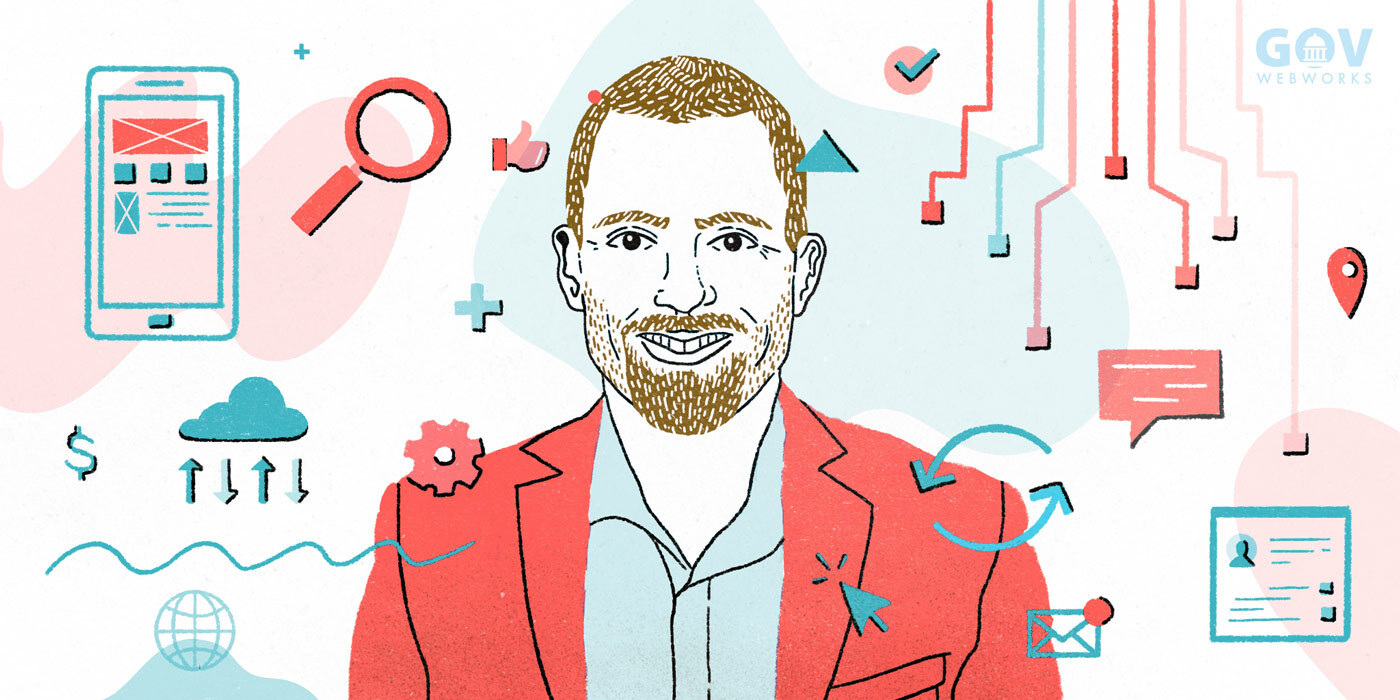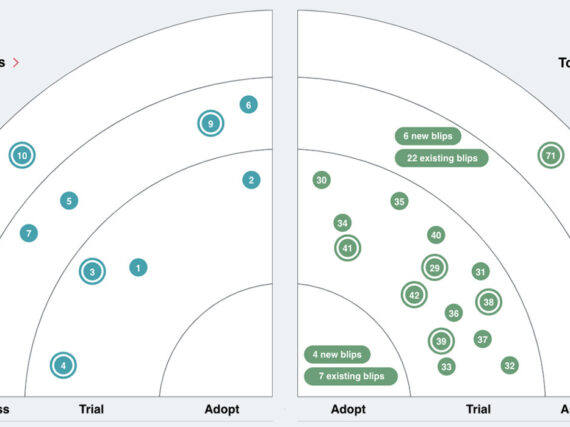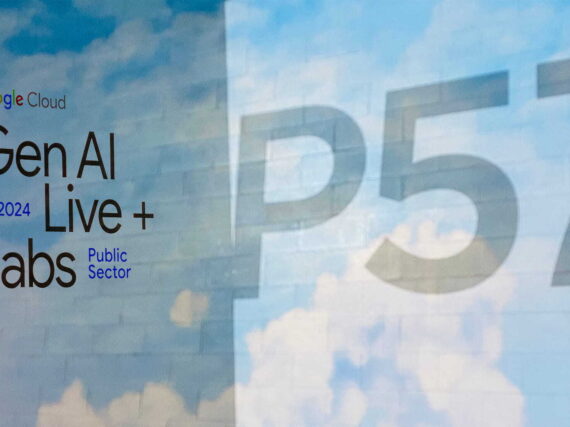For Jamie Brennan, a good day at work means people have access to better online tools for state social service programs. A project manager and consultant, he supports state governments in maintaining federal compliance while achieving goals around benefits programs, especially for integrated eligibility systems (IES). In other words, he makes sure the red tape doesn’t get in the way of citizens finding help.
“Integrated eligibility systems are the gateway to state benefits for citizens,” Jamie explains. “It might be medical coverage through Medicaid or the children’s health program, help buying nutritious food through SNAP*, or childcare benefits. From an information technology perspective, there’s no more important place to support people in need.”
(*See glossary of acronyms at bottom.)
Over the past decade, one of his main goals has been to modernize state IES and enrollment solutions, and support the integration of health and social services programs and Medicaid. This includes his work with RFP development for a state client to consolidate traditional assistance programs (Medicaid, CHIP, TANF, SNAP), social services (Foster Care, CPS, APS), and child support into a single solution.
At GovWebworks (GWW), he’s now supporting our clients in making their benefits programs more accessible in order to reach citizens who may be smartphone only visitors (as noted by Pew, 15 percent of Americans are smartphone only). This is just one way states are updating IES solutions, and Jamie has put a lot of thought into what more needs to be done.
We asked him to share his insights on how states can modernize their tech to make online benefits systems more successful.
Why is it important for states to modernize legacy IES systems?
One of the drivers for modernizing IES is the evolving expectation people have about how they interact with government digitally. The expectation is that I should be able to get the same level of service from my government as I get from Walmart or Amazon or any of these other large companies that are delivering digital services effectively.
Oftentimes that’s just not the case. It’s often a lengthy application process due to the non-user-friendly content that’s made available to people on public-facing portals. And when folks submit applications, they find themselves waiting for responses and receiving lengthy and often difficult-to-understand notices in the mail.
“Poor usability creates a gulf between the experience people have when interacting with government social or human services and everywhere else in the digital world.”
What are some issues that need updating?
A good example is mobile accessibility. Many states are struggling to implement public facing portals that are targeted to mobile users. For example, if I’m on my cell phone and I log in to check my benefits or report a new job that might change what I’m eligible for, I’m looking at a desktop screen squeezed into my cell phone and it’s almost impossible to do anything because I’m trying to answer questions and navigate a complex application flow. As a government agency delivering critical support to the public, that’s hard to justify when you compare that experience to every other retailer or bank that has a mobile directed presence.
For a long time, the assumption was that the lower income bracket didn’t have cell phones, but that’s really changed dramatically in the last few years with the rapid expansion of low cost smartphones. Entry level smartphones now cost less than a laptop. You have people stepping into that mobile realm that weren’t there previously. I see HHS agencies lagging behind this migration to mobile.
“Modernization, when done right, offers an opportunity to refocus and improve user experience in these systems, whether for citizens accessing services via cell phone or for state staff navigating complex workflows in the admin portal.”
What can states gain from IES modernization?
One benefit is cost savings that comes with simplifying state IT infrastructure. Often Health and Human Services (HHS) agencies have many different systems that manage different programs. Some have one for child support, another for childcare, another for Medicaid, SNAP, TANF, and another for social services. It’s silos and sprawl. At their core, all these systems are doing case management. They check if you are eligible for benefits or services and make sure you can continue to be eligible and distribute those benefits or services out to you. Each separate system is essentially doing the same thing with some minor nuances.
What makes modernization attractive to IT departments is the ability to consolidate that IT footprint and reduce this reliance on siloed systems that have separate data about many of the same citizens. They can create single sources of data that can be reused to maintain up-to-date information across all programs.
“If you can consolidate four or five systems down to one or two, you’re saving a lot of time on patching, deployments, and upgrades for duplicate technology architecture. And on cost for maintenance and operations.”
How did IES get so dispersed?
When states first started rolling out HHS IT systems, the world was a very different place technologically, and they were using COBOL (Common Business-Oriented Language) on mainframes. There was no way to make one system do different things in that legacy technology environment. Now it’s a totally different world. There’s so much more flexibility in modern IT systems today to handle multiple different types of business needs on the same platform.
Another reason has to do with the funding sources that come from the federal government. Office of Child Support Enforcement (OCSE) funding is totally separate from Centers for Medicare and Medicaid Services (CMS) which is different from Food and Nutrition Service (FNS) which oversees the Supplemental Nutrition Assistance Program (SNAP) which is separate from the Children’s Bureau which oversees child welfare programs. And each of them, while they all use Advanced Planning Documents (APDs), have their own set of requirements for how you get funding and different levels of detail when it comes to cost allocation methodologies to tell who’s going to pay for what pieces of the system. They also have different expectations to demonstrate compliance for federal requirements. Every single federal agency is different, even down to the federal financial participation rates (the proportion of the project cost the agency will pay).
For example, if you’re working with CMS, you can get 90 percent of the cost covered by federal funds to modernize your IES, but Food and Nutrition Service (FNS) only provides 50 percent. OCSE provides 66 percent.
“So, there’s an incentive to keep working on the CMS side where you can get 90-10 federal match and a lesser incentive to modernize in areas where you get much lower matches, because state budgets are tight and are always going to be tight.”
Are there ways to get around these issues?
When the A87 waiver was available during and after the Affordable Care Act (ACA) implementation, we saw a profusion of modernization. Suddenly this overhead associated with allocating cost and accounting for varying federal match rates in project planning disappeared, you could just get 90-10 from CMS and it didn’t matter if it was for SNAP or TANF and that made it much easier for states to justify modernization within their budgets. When that expired, cost allocation methodologies reemerged to accommodate individual federal agency’s funding levels. It’s an incredibly complex calculation to determine which money goes where, and which federal partner is going to fund your project. That’s another reason things are siloed.
“It would be great to see federal partners coming together and jointly managing projects. In some states they are trying to do that, but there’s still a long way to go in terms of our federal partners bringing a unified front to modernization of IT systems serving all these different programs.”
What are other hurdles to IES modernization?
“Cost is a big one. If you want to upgrade an IES system, it can be anywhere from $80 to several hundred million dollars.”
And these big implementations are still fraught with risk and failure. It’s easy to find IES systems that did not make it all the way through the design, development, and implementation (DDI) phase or made it through DDI and then had major issues during operations. That’s another reason some states may look at their IES and say, “Well, it’s working, why would we bite off a big risky project like this when it’s working as is?” That’s why states ended up modernizing COBOL mainframe systems during the ACA implementation, over a decade after COBOL had largely fallen out of favor in the private sector. When you start to fall behind, you get further behind the curve of technology that supports these systems.
Why isn’t there a push for more modernization?
Certainly some of it relates to state governments and the vendors in the space showing their scars from the Affordable Care Act rollout, which forced states to modernize and innovate at a breakneck pace and was fraught with project failures and missteps. Even though it was almost 10 years ago, I think some of those difficult experiences from the past are making states wary of biting off more big changes.
“That said, a lack of true innovation in the space is also a challenge. A lot of times we see the same small set of large vendors bidding on every opportunity and delivering repeatedly the same system they just delivered in the last state.”
The system is slightly tweaked for each state but carrying forward the tech debt that already existed from the prior implementation. That debt accumulates until they get two or three states down the road, and have an amalgamation of code that’s been tweaked and tweaked but never actually optimized for any one state. There’s just not enough true innovation happening in IES today.
Why don’t companies bring more innovation?
The experience of the user is often lost in the drive to deliver technology more quickly. It’s a problem for the IES space. That’s one of the reasons why I joined up with GovWebworks. I see GWW taking a user centered design approach to IES. Instead of having the tech drive the business, GWW brings the perspective that the experience the user has in the system is what matters most.
From a person who lost their job and needs to get Medicaid quickly, to a county operations officer who has to process applications quickly because they have 15 people in the waiting room, what matters is that people have a positive interaction with the system and get their needs met.”
“A focus on user experience is one reason commercial systems continue to leap ahead of government. Private companies know that the experience people have using their platform can be a differentiator between someone becoming a loyal customer or choosing another brand. Government doesn’t have to compete for its customers, so the drive for innovation to survive is less intense.”
Any examples of federal agencies trying to change the dynamic?
Definitely, CMS is always trying to innovate. A great example is the Administration for Children and Families and the Children’s Bureau. In 2016, they reimagined the way they wanted child welfare systems to be purchased, built, and operated. They shifted away from these big monolithic systems to modular systems that are smaller.
Sadly, states are having difficulty breaking up that one big procurement for a child welfare system into four or five individual components for the automated functions, because there’s no one offering services at that small scope in the marketplace. The companies offering the old systems rebranded them as the new systems and created documentation suggesting they align with the new standards, but under the hood they are still the same systems.
“ACF is driving everyone in the direction of smaller procurements, but there’s no innovative vendors doing what they need to do. So states are in a difficult position where they may want to embrace the new approach from ACF, but the marketplace doesn’t support it.”
What could the future look like for IES?
I can imagine a future where IES is offered in a Software as a Service (SaaS) model, like health insurance exchange services that are gaining popularity today. You could have a company selling an IES solution as a SaaS product in the cloud that can be easily configured state-to-state. They could maintain a core set of code for that product and on top of that is a set of configurations that apply to each individual state. If you roll out a change to the SaaS side, it applies to all clients so it helps everyone and the cost gets spread out among multiple states. That allows states to get IES for much less than they do today.
“A SaaS model allows for a more streamlined approach to maintaining those systems and keeping them on the cutting edge. I see that as a realistic direction for IES and one that would benefit state governments in a meaningful way by reducing cost, reducing risk, and increasing innovation.”
*Alphabetical Acronym Glossary:
- ACA – Affordable Care Act
- APDs – Advanced Planning Documents
- APS – Adult Protective Service
- CHIP – Children’s Health Insurance Program
- CMS – Centers for Medicare and Medicaid Services
- COBOL – Common Business-Oriented Language
- CPS – Child Protective Services
- DDI – Design, Development, and Implementation
- FNS – Food and Nutrition Service
- GWW – GovWebworks
- IDHW – Idaho Department of Health and Welfare
- IES – Integrated Eligibility Systems
- HHS – Health and Human Services
- RFP – Request for Proposals
- SaaS – Software as a Service
- SNAP – Supplemental Nutrition Assistance Program
- TANF – Temporary Assistance for Needy Families
- OCSE – Office of Child Support Enforcement
Learn more
- Contact us to learn how we can help with IES modernization
- Integrated Eligibility: Where to Next? Has integrated eligibility been achieved and if not, what remains to be done?, CompTIA
- Insights into better integrated eligibility systems, McKinsey







